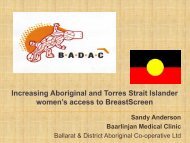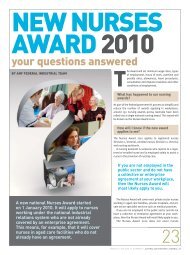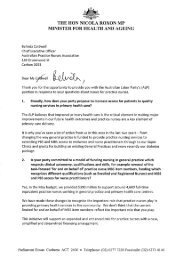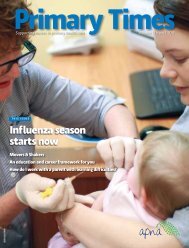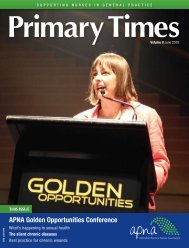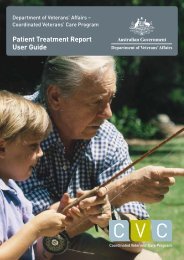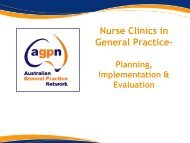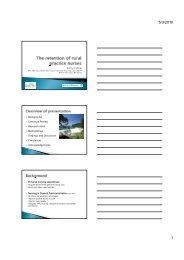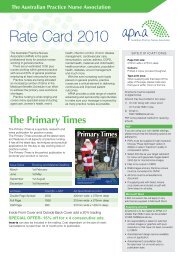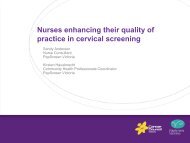September - APNA
September - APNA
September - APNA
You also want an ePaper? Increase the reach of your titles
YUMPU automatically turns print PDFs into web optimized ePapers that Google loves.
PRESIDENT AND CEO MESSAGES<br />
Reflections from the President<br />
It’s been a very busy few months for <strong>APNA</strong> and<br />
for me as the new President.<br />
Within hours of being elected as <strong>APNA</strong> President<br />
I was off to New Zealand with Belinda Caldwell,<br />
our dynamic CEO, to visit general practices and Primary<br />
Health Organisations (PHOs); which have a similar role<br />
to our Divisions in Australia. We met several amazing<br />
nurses working in many varied roles.<br />
Nurse practitioners in NZ are a growing primary<br />
healthcare workforce, further progressed and entrenched<br />
in the primary healthcare system than the Australian<br />
sector and much respected by their colleagues in<br />
general practice. I was equally impressed by the<br />
nurses that work on the frontline of general practice.<br />
Much of their basic day-to-day work is similar to the<br />
PN role in Australia, in that they run acute clinics daily,<br />
triage unbooked clients, organise and manage chronic<br />
disease self management clinics, and plan and run<br />
preventive health programs.<br />
What stood out was that the PNs in the PHOs we<br />
visited are well respected by their clients and colleagues<br />
and are reasonably renumerated for their contribution<br />
to the health of the population they serve. They also<br />
have a well structured career path that allows for<br />
growth and development in areas of interest. The<br />
PHOs, in line with the national registration boards,<br />
run graduate nursing entry to practice programs in<br />
general practice, based on competencies that are well<br />
structured and allow for individualised learning plans<br />
Looking to the future<br />
and the development of portfolios against knowledge,<br />
skills and scope of practice. These nurses each have an<br />
enthusiastic preceptor who is constantly challenged,<br />
educated and supported to provide a balanced<br />
educative experience with learning objectives and<br />
demonstrated outcomes.<br />
There is a prevalence of PNs at every level in the<br />
NZ health system. Since the establishment of the NZ<br />
Primary Health Care Strategy in 2001, there has been<br />
a business case for the development of a Primary<br />
Health Care nursing strategic plan in 2010, which has<br />
nurses on the advisory group. District Health Boards<br />
(DHB) have Directors of Nursing, nurses are on the<br />
boards of DHBs and PHOs, and several of the PHOs<br />
have nursing development teams with nurses employed<br />
as Nurse Leaders.<br />
PHOs encourage nurse leaders to run dynamic<br />
preventive health decision support programs and the<br />
data from these feed back from the general practice<br />
to the PHOs — the evidence ensuring funding of<br />
future projects.<br />
At the end of our tour we attended the 2010 NZ<br />
Primary Health Care Nurses Conference in Auckland.<br />
It provided a wonderful opportunity to hear more about<br />
the inspiring work of nurses in primary healthcare in<br />
NZ. The culmination of the conference was the official<br />
launch of the NZ College of Primary Health Care Nurses.<br />
The College is a merger of three colleges and sections,<br />
and is made up of members from the former New<br />
Zealand Nurses Organisation (NZNO) District Nurses<br />
Section, Public Health Nurses Section (NZNO) and NZ<br />
College of Practice Nurses (NZNO).<br />
We are delighted to hear that our NZ colleague<br />
Rosemary Minto was recently elected as the chair of<br />
the NZNO’s 2000-strong College of Primary Health<br />
Care Nurses. Debbie Davies and Rachel Calverley are<br />
also on the executive committee of the College. These<br />
three amazing primary healthcare nurses attended the<br />
<strong>APNA</strong> 2010 conference and shared their stories of<br />
hard work, growth and development of nursing. They<br />
have been instrumental in the development of nursing<br />
into a respected and well structured career path for<br />
primary healthcare nurses.<br />
We look forward to continuing our friendship with our<br />
NZ colleagues and extending our international links to<br />
further value add to <strong>APNA</strong>’s growth and development.<br />
Finally, I would like to thank our immediate past<br />
president Anne Matyear who has led us so well and<br />
continues to support and mentor me on my journey as<br />
<strong>APNA</strong> President for 2010. Thanks so much Anne.<br />
Julianne Badenoch<br />
President<br />
Australian Practice Nurses<br />
Association<br />
We finally know what the future holds, or have<br />
a better idea of its general direction, now that<br />
the Australian government has been formed.<br />
delayed writing this message until the announcement,<br />
I as the policy differences between a Coalition and<br />
Labor government has significant ramifications for<br />
primary care nurses and for <strong>APNA</strong>.<br />
It was a busy period while we attempted to have a<br />
voice in the election campaign and provide members<br />
with an overview of the different policies proposed in<br />
general practice and health. It has been great to see<br />
members engaged in the process, putting their<br />
tuppence worth in and at times holding us to account.<br />
Member engagement is a key achievement for which<br />
we aim and encourage.<br />
Now we know what lies ahead, we can get down to<br />
the task of advocating for nurses on primary<br />
healthcare reform, including the practice nurse funding<br />
incentive, formation of primary healthcare organisations<br />
(Medicare Locals), after hours telephone triage,<br />
telehealth consultations and patient controlled electronic<br />
health records. It will be a busy time and I look forward<br />
to engaging with members over their experiences and<br />
views of the challenges and opportunities for nursing<br />
in each of the proposed reforms.<br />
The conference committee 2011 has met and<br />
developed a very exciting and robust program for next<br />
year’s conference, to be held in Sydney (see ad on<br />
page 5). Members of the committee range from ENs,<br />
RNs and a NP candidate, and also have an academic<br />
and public health nurse in the mix. Rural and city<br />
locations are also well represented. I cannot speak<br />
more highly of the value of grass roots members<br />
taking full ownership of the conference program.<br />
Finally, in response to the <strong>APNA</strong> member survey,<br />
you may have noticed we have ramped up the<br />
member rewards program. The intention is to provide<br />
value to members and, in some cases, revenue to<br />
the association, so that we can limit the need for<br />
membership subscription increases. However, we are<br />
monitoring for impact and suitability and welcome<br />
any feedback as to level of benefit of such programs.<br />
We also welcome suggestions of other companies<br />
we could approach.<br />
Belinda Caldwell, MPH<br />
Chief Executive Officer<br />
Australian Practice Nurses Association<br />
belinda.caldwell@apna.asn.au<br />
2<br />
Primary Times <strong>September</strong> 2010



